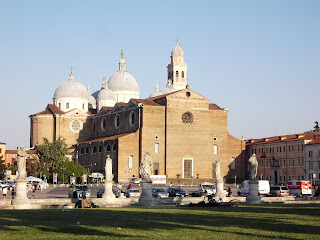Cousin of brilliant painter left mark on Padua
 |
| The Basilica of Santa Giustina in Padua is arguably Andrea Moroni's most famous work |
Born into a family of stonecutters in Albino near Bergamo in Lombardy, Moroni was the cousin and contemporary of Giovanni Battista Moroni, the brilliant Bergamo painter, who was also born in Albino.
Moroni the architect has works attributed to him in Brescia, another city in Lombardy about 50km (31 miles) east of Bergamo. He is known to have been in the city between 1527 and 1532 where he built a choir for the monastery of Santa Giulia.
He probably also designed the building in which the nuns could attend mass in the monastery of Santa Giulia and worked on the church of San Faustino.
As a result, he made his name with the Benedictine Order and obtained commissions for two Benedictine churches in Padua, Santa Maria di Praglia and the more famous Santa Giustina.
His contract with Santa Giustina was renewed every ten years until his death and he settled down to live in Padua.
.jpg) |
| Moroni supervised the construction of Palazzo del Bo, the university building in the centre of Padua |
Moroni was also involved in the construction of the Orto Botanico, Padua’s famous botanical gardens, where medicinal plants were grown, and some of the university buildings.
It is known that he supervised the construction of Palazzo del Bo, the main university building in the city, but there is some controversy over who designed the internal courtyard. Famous names such as Jacopo Sansovino and Andrea Palladio have been suggested rather than Moroni.
However the Loggia of the Palazzo del Capitaniato and the Palazetto have been attributed to him, along with Palazzo Zacco and the Charterhouse of Vigodarzere.
Some architectural historians believe Moroni’s reputation as an architect, and the question marks over whether some buildings attributed to him were really the work of others, may have suffered because his career coincided with that of Palladio.
Travel tip:%20(2).jpg)
The Chapel of St Luke at the Basilica di Santa,
where the remains of the saint are said to rest
The Basilica di Santa Giustina in Padua is at the south-east corner of the square called Prato della Valle, where it is joined by Via Avezzano and Via Ferrari. At the back of the Presbytery, a magnificent altarpiece painted by Paolo Veronese in 1575 depicts the moment of her death. The basilica also contains Jacopo Bassano’s Santa Giustina enthroned with the saints Sebastian, Antonio Abate and Rocco, which was painted by him in around 1560 with the help of his son, Francesco, and is considered one of the most original examples of the Venetian Mannerist culture. Next door to the basilica there is a Benedictine monastery with frescoed cloisters and a famous library that can be visited by arrangement. The remains of Santa Giustina, a devout young woman who was martyred in 304, are buried in the church, which is also home to the tomb containing the body of St Luke the Evangelist, who was credited with writing the Gospel according to St Luke.
Travel tip:.jpg)
The Orto Botanico in Padua, now a UNESCO heritage
site, is thought to the world's first botanical garden
Padua’s Botanical Garden (Orto Botanico), which was created in 1545, is thought to be the world’s first botanical garden. Now a UNESCO World Heritage Site, the garden, which still belongs to the University of Padua, is in Via Orto Botanico close to Prato della Valle. When it was founded, the garden was devoted to the growth of medicinal plants that could provide natural remedies. According to UNESCO, the garden has made a profound contribution to the development of many modern scientific disciplines, notably botany, medicine, chemistry, ecology and pharmacy. The garden was designed by Moroni as a circle enclosing a square divided into four quadrants, in which the plants were grown. The Orto Botanico is open to the public every day apart from working Mondays with an entry fee of €10.
No comments:
Post a Comment